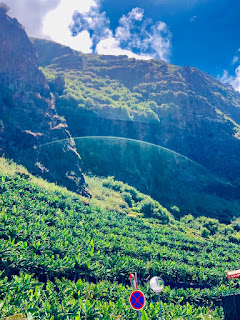Walk through a banana plantation in Madeira
Walk through a banana plantation in Madeira
Banana plantations on the south side of Madeira Island
Today we got to visit a banana plantation in Madeira on the south side of the island.
Nature walk through a banana plantation in Madeira
Proximity to the sea, sun exposure, mild climate throughout the year, fertility of the soil, the tradition of Bananeira and a unique irrigation system called levadas, make the bananas grown in Madeira absolutely delicious bananas, known for their intense flavour and aroma. Locals grow many distinct varieties that are eaten raw, used in cakes, mousses, ice creams and pancakes and even used to flavour rum.
The edible banana is a long elongated fruit (technically a berry) of one of more than 80 species of the genus Musa, of the family Musaceae. It is also one of the most important cash crops in the world, beloved for its flavour, nutritional value, and availability throughout the year.
Did you know that bananas (Musa species and cultivars) originated in SE Asia and that they are distant relatives of Gingers, Heliconias and Bird-of-paradise flowers?
Hang gliding above the banana plantations in Madeira
Bananas are fast-growing tropical or subtropical perennial herbs, upright 5 to 25 feet depending on the cultivar, grown from underground corms or rhizomes (a stem that sends out roots and shoots from its nodes).
Cross-section of banana trunk showing the series of overlapping stalks
A banana plant takes approximately nine months to mature and produce fruit
Flowering stalk of Banana
Banana plants are heavy feeders and love to be planted into deep well-drained soil that is laden with compost and other organic matter including well-rotted animal manure.
Wooden supports to hold up the 30 kg bunch of bananas
Commercial farmers cover the entire fruiting stem of bananas with a large open-ended bag once the fruit moves from being downward to upward facing. Not only does this prevent fungus from the jelly-like sap, but it also helps deter flying foxes, possums and birds from eating the bananas.
As an added precaution, farmers protect the banana hand from swaying too much and to avoid any damage the fragile skin of the fruit - this drastically reduces the commercial value of the crop.
Nematodes, black banana weevils, mealybugs, red spider mites, aphids and thrips are the most common pests while anthracnose, rhizome soft rot, banana leaf rust, leaf speckle and crown rot are common diseases.
Conventional wisdom says that once a banana plant has fruited it will die. Before it dies, it sends up multiple suckers to take its place. Remove all apart from one or two of the strongest suckers. Ultimately keep only the strongest sucker to replace the mother plant. However, in Madeira farmers have realised that after the banana plants have fruited they cut it in half - allowing a second crop to develop in less time than it takes for a new one to grow. This can only be done one time.
Levadas of Madeira
Levada carrying irrigation water to the banana plantation
The origin of the levadas dates back to the first settlements of Madeira Island, in the first quarter of the 15th century, when water became necessary to water farmlands, particularly sugar cane fields – the first crop of high economic value in Madeira – and for the functioning of the first mills and sugar factories. It is worth noting that in the second half of the 15th century, water carried by levadas was essential to Madeira Island’s becoming one of the largest producers and exporters of sugar in Europe, the “World” of those days.
According to the chronicles of the time, the first levadas were rudimentary waterways, short and dug out in the volcanic tufts. When the rock was so hard that the levada frame could not be dug, segments built out of wood from endemic species such as Madeira laurel (Ocotea foetens) or Canary laurel (Appollonias barbujana) would be used in the shape of a gutter.
With the ongoing expansion of farming operations, first with the cultivation of sugar cane, then later with winegrowing, and nowadays with the cultivation of bananas, the levadas network kept growing all over the island and its construction demanded more advanced techniques.
The early gave place to waterways built in basalt rock masonry, some of them being basalt cobblestone aqueducts. The most common cross sections were under one metre in width and the depth varied between fifty and seventy centimetres.
References:
- Things to do in Madeira: Visit a Banana Farm. (n.d.). Portugal Farm Experience. Retrieved May 11, 2024, from https://www.portugalfarmexperience.com/blog/things-to-do-in-madeira/
- The Editors of Encyclopaedia Britannica. (2024, May 8). Banana : Description, history, cultivation, nutrition, benefits, & facts. Encyclopedia Britannica. Retrieved May 11, 2024, from https://www.britannica.com/plant/banana-plant
- Permanent Delegation of Portugal to UNESCO. (2017, January 31). Levadas of Madeira Island. UNESCO World Heritage Center. Retrieved May 11, 2024, from https://whc.unesco.org/en/tentativelists/6230/










Lots of information about the ubiquitous banana, which I didn't know. Thanks
ReplyDeleteThanks for the info better then hearing a lecture
ReplyDelete